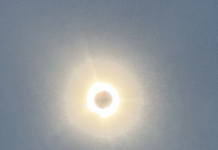
illustration by lars leetaru
A few months ago, during a below-zero stretch of snowy February days, I glimpsed my neighbor, clad in running pants and boots, hunching furtively over his grill. (There’s nothing like a 20-below wind chill to make you look like you’re hiding something.) He prodded what looked like, from a distance, a large fish.
Was he committing a clandestine act of extreme barbecue, or simply embracing the culinary spirit of Minnesota’s original inhabitants, the Ojibwe and Sioux? Either way, as I watched my neighbor brace himself against the wind, I felt a twinge of envy.
My attempts to command the grill at summer barbecues have been repeatedly rebuffed with vaguely menacing phrases like, “Go away, vegetarian.” (Lapsed, to be precise.) In my years as a Girl Scout, I learned how to start a fire using a mirror and a handful of dry sticks. Still, nobody has ever trusted me with an open fire and a large quantity of raw meat.
I could blame my background, a hodgepodge of Scandi roots—some Swedish here, a little Finnish there. Somehow, I imagined that, for my Nordic ancestors, cold and rainy climates had made cooking outside so unappealing that they preferred to hover indoors over blistering cauldrons.
But that was before I discovered a Finnish invention fascinating enough to rival the mighty sauna—the grillikota. It’s quite possibly the world’s coolest outdoor barbecue apparatus. Imagine opening the door of a tiny, fairytale cabin: Inside, you find an open-fire stove encircled by cozy wooden benches. (Reindeer pelts optional.) Obviously, Pinterest has plenty of examples.
Finnish for “grill house,” the grillikota can be credited to the adventurous spirit and ingenuity of the Sami. An indigenous people, the Sami inhabit the remote, ethereal lands that stretch across the northernmost reaches of Norway, Sweden, Finland, and Western Russia—dotted with fjords, glaciers, lakes, and mountains.
Known for reindeer herding, fur trapping, fishing, and folk art, the Sami constructed their original grillikotas, similar to teepees, from reindeer hides. Linguists say the complex etymology of “Finnish” bears relation to Old High German terms for “to find” and “wanderer,” likely tied to the hunter-gatherer Sami’s foraging and agricultural traditions.
Armed with newfound knowledge that perhaps the DNA for open-fire cooking does run in my blood, I decided this will finally be the summer I learn to grill. Now that I’m a parent, shouldn’t I know how to provide for my young if we ever got lost in the wilderness and ran out of granola bars?
I’ll take a cue from my late grandfather, who lorded over the grill every July 4 with good humor and aplomb, wearing his signature outfit: Bermuda shorts, polo shirt, and Golden Gophers baseball hat. So what if the burgers occasionally turned out faintly charred? He took his role as grillmaster seriously, knowing that the one who presides over the grill doubles as master of ceremonies: telling jokes, ribbing his brother-in-law, keeping the crowd fed, and the kids laughing.
When you’re appointed master of the grill, someone always makes sure you have a cold beer in your hand. In return, you make sure the bratwurst grease doesn’t splatter over the veggie dogs, and that your uncle’s deck doesn’t accidentally burn down. You might not be a culinary genius who can spot a burger’s sweet spot, exactly as it hits medium-well, but you’re the keeper of the flame.
Somebody hand me that spatula. I’m ready.






